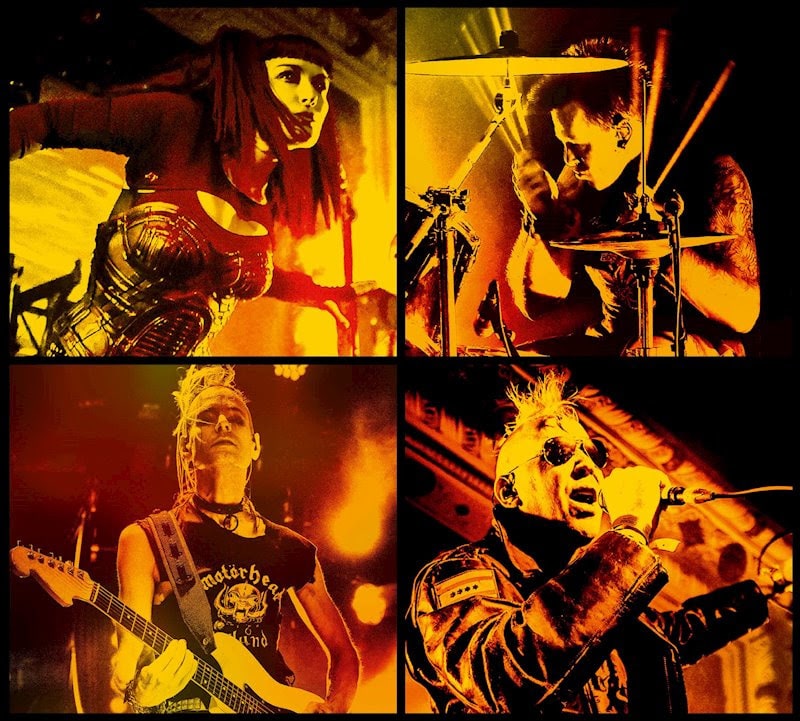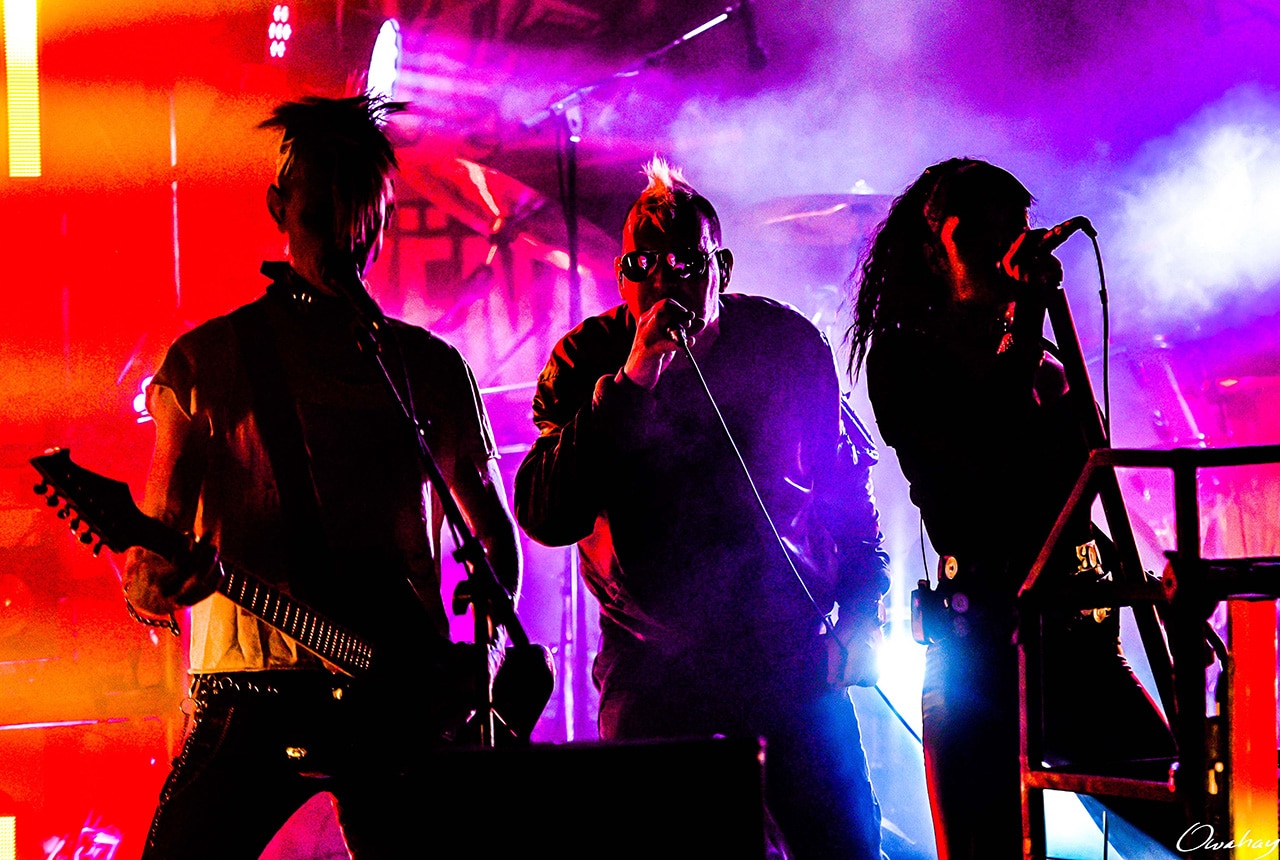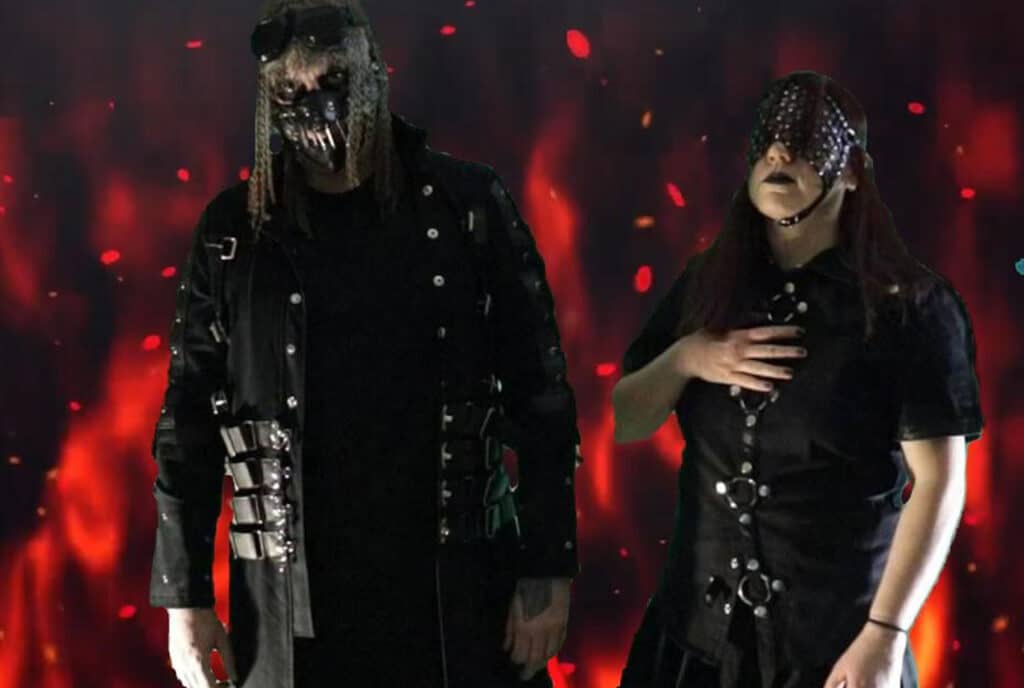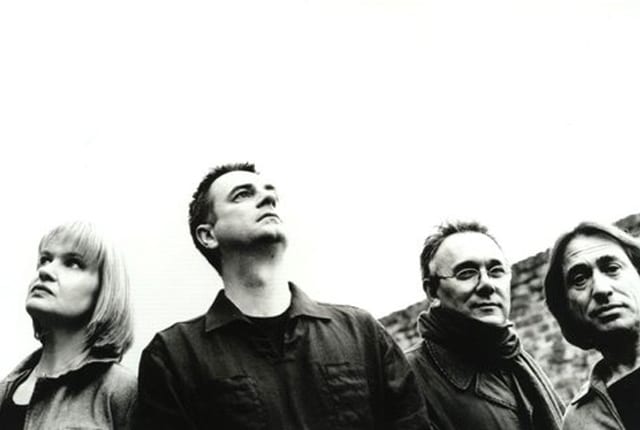While many bands commemorate anniversaries by touring classic albums, KMFDM do not see their 40th year as a milestone requiring nostalgia. Rather, they are touring to support Let Go, a new album that represents yet another evolution for KMFDM. As usual, KMFDM brings together aggressive beats, electronics, and heavy guitars with strong melodic hooks. For Let Go, they made a point of creating a more cohesive and immersive experience than past releases, an album truly meant to be listened to from start to finish. The current KMFDM line-up is founding member Sascha Konietzko, Lucia Cifarelli, Andy Selway, and Andee Blacksugar. Over a Zoom interview, they talked about the making of Let Go and other topics.
Were there any major differences in terms of the creative or recording process this time around?
Sascha Konietzko: It’s really different each and every time. What was different this time, really, was that I had an idea of a concept for an album, and I really wanted to make an album that, unlike so much music today, you should not really be encouraged to play on shuffle. I wanted to make an album that really has a beginning and the middle and an ending, like a book. And you wouldn’t start reading a book in the middle and then [read] the end and then the beginning. So the idea was to make a visual album, like a journey almost, like a soundtrack. And so that was one of the big differences to previous albums, where it was just really throw a lot of stuff to the wall and see what sticks. This was more like honed and carefully created, so to speak.
Given that, did the journey evolve much during the process? Are there any particular ways that the concepts or musical approach changed as you got into it?
Sascha Konietzko: Well, the process of making a KMFDM album is a very sort of painstaking one in the respect that, usually, it’s me that starts with ideas, and then once I have something going that’s sometimes very small, just like a few bars or a baseline and a beat or something, then I start passing it around to my bandmates, Lucia and Andee Blacksugar and Andy Selway. Then they get to get active on the ideas, and if they like them, then they do more stuff. And if they don’t like them, then they say, “Yeah, we don’t like them,” and then I usually bury the stuff. So in the end, it’s very hard to trace back where each and every individual track really has begun and as what it has begun. I sometimes look at my backup hard drive, and I go, “Oh, the working title for this was whatever. Oh, yeah.” But we do tend to turn things inside out and do a lot of changing around, and oftentimes, out of a song that lasts maybe six, seven minutes, I cut out a three-and-a-half-minute version because some songs don’t need to be long. Some do, but some don’t. And especially with the relatively short attention span that people, including myself, obviously, have nowadays. Sometimes I feel like less is more, quality of the quantity.
To what degree did you discard things that didn’t fit versus spending extra time shaping it to work?
Sascha Konietzko: There’s a lot of discarding going on in general, and particularly loads of discarding on this album. I don’t really like the idea of putting things into a bin and then looking at them a few years later. So usually what I do is, really, I delete the stuff, and then it’s gone, so I never get tempted again to go the easy route and sort of revitalize something that was stillborn in the first place.
On this album, was it always obvious who would do vocals on a particular track as you were creating them?
Sascha Konietzko: No. For instance, the track “Airhead,” I found it intriguing because it had this very plodding kind of nature, and it was melodious but somehow slow. And just as I was working on it and thinking, “I don’t know if this goes anywhere,” then all of a sudden Lucia walked into my studio, and she immediately said, “Oh, I love this. Send it to me. Don’t change a thing.” And literally within an hour, she came back, and she had written the lyrics, and I was like, “All right, this just turned the corner right here, right now, because it might’ve ended up in the dustbin.” And this is kind of how it goes. Some songs I write specifically for me. I know my range is somewhat limited and certain chords work better than others. But generally speaking, there’s just this outflow of stuff, which is not so much inspired by anything in particular.
It’s more like I attempt my initial work on an album rather with discipline than with, like, “Wow, oh, I have all these ideas.” I mean, the ideas come as I work with something, but it’s kind of finding a stone somewhere in a mudslide and polishing it. I start with something that’s maybe just like a sketched down idea for a drumbeat or an idea for a baseline or a found sound, and that then gets meticulously shaped and played and fiddled with until something happens, or it doesn’t. And if I start something and within an hour or two I don’t really feel like this is going somewhere, then I’ll just start something else, do my taxes or clean the house, something like that.

As you’ve been doing music for a long time, has the evolution of musical technology changed your process or workflow?
Sascha Konietzko: Well, very obviously, back in the days that one would rent a music recording studio, once you set up a song to record and mix, you had to sort of finish it because there was an assistant in the studio that would just keep track of where each and every cable was plugged into, the settings of the reverb and the delay and the compressor settings, and all that kind of stuff. So you had to more or less finish what you had begun before striking the board and starting something new. Obviously, with digital workstations nowadays, you can completely omit all the documentation because it’s all in there. It’s just saved with each session. And so that makes it possible to skip through a bunch of things that you’re working on, on a daily basis, and just add a little here or EQ a little bit there and then skip to the next song, do a little working on that and then skip around.
And so yeah, the workflow has become much more intuitive and you’re not forced to look through something start to finish and then be done with it, and then potentially being unhappy with it and having to start all over. Technology really helps with that. And also, in the sense that my drummer, Andy Salway, he lives in Florida and Andee Black Sugar in Brooklyn, and Lucia and I are here in Germany, so sometimes I send something off to the guys in the US in the evening and then the next morning I wake up to a new drum track and some guitar takes. And this is really a very efficient way of working, probably much more so than if we were just all hanging out in a room and then we would goof off and go for expensive dinners and stuff like that. So this way we can maintain a certain immediate and urgent kind of workflow.
Are there any disadvantages to working long distance like that?
Sascha Konietzko: Yeah, I miss seeing them. But no, I see ‘em soon enough because we’re going on the road, and we’ve just been out on the road in May ’23. So it really is always only a couple of months in between us hanging out and enjoying each other’s company. But that’s a really important thing with KMFDM too. This current line-up is super harmonious in a way that we actually don’t just work together. We actually like each other a lot.
Do you have to consider how something will ultimately be performed live, as, for example, you’re not with your drummer when you create the track?
Sascha Konietzko: Not really, no. I mean, what comes first really is the album version and then it is determined whether or not something is even playable in a live kind of environment. And if that is the case, then, for instance, if there’s a one-minute intro, which there are a couple of on the “Let Go” album, nobody needs those in a live situation. For a live show, you want to be like bam, bam, bam, jump, high energy. So yeah, stuff gets oftentimes rearranged, parts get maybe simplified so they’re really playable, because obviously when you have 24 guitar takes, there’s only so much the guy can actually really do in a live set. It gets kind of condensed and honed, sharpened and brought to the point.
What can we expect from the upcoming tour? Does the fact that it’s your 40th-anniversary impact the setlist?
Sascha Konietzko: Well, as always, it’s going to be a mix of new and medium and older stuff. So quite a bit of thought goes into it. We don’t want to harken back too much, but just about enough. And there needs to be a balance of new stuff, because oftentimes it’s like people stand there and look at you. And they go, “what are they even playing? I haven’t even heard that yet.” So it’s important to have a little bit of a delay between the release of a new album and the first live dates. It’s a 40th anniversary, but that really is not so very important. It just happens to be the 40th when last year was the 39th, and next year will most likely be the 41st. So it’s really not about these types of things. I don’t count them as milestones. It’s more like the way is the goal, like in classical Dao philosophy. It’s doing it, not about reaching milestones.
Back when I first got into KMFDM, I was one of many people who would buy or at least check out anything on Wax Trax! But now, in terms of musical discovery, everyone has virtually everything at their fingertips. What are your thoughts on how people discover music now, and how they are finding out about KMFDM?
Sascha Konietzko: Yeah, that’s actually a very interesting question. We released the second single, “Airhead”, with a very sort of tongue-in-cheek video with all these clips from the seventies and eighties, and it got a lot of views on YouTube in the initial first couple of days. I looked at the analytics, and it was, something, like, close to 60% of the views were because YouTube recommended the video to people. So logically, in the comments, there were a lot of people like, “Wow, I never had any idea that this band even existed. I just bought five albums just yesterday because I really liked the song, and I wanted to dive into the whole thing a little bit.” So that was positive and surprising. A lot of the older fans feel compelled to just not like stuff because certain members are not in the lineup anymore or because nothing can get better than a certain album from a certain time period, which I totally understand. I mean, I used to love David Bowie, and at some point what David Bowie did wasn’t appealing to me anymore. So I just content myself with listening to the David Bowie stuff from the time that I liked. But I don’t necessarily have to go about and just bitch on every David Bowie forum about how bad he kind of sucked.
Obviously it’s the internet, and we do see an uptick in ticket sales all of a sudden, which must coincide with the release of this video. And something I’ve noticed in the past couple of years, especially post Covid, is that there is a large part of the audience that has become completely rejuvenated. We see kids that are underage at our shows in the first row, which is kind of unusual. I mean, it used to be a slightly older crowd, and all of a sudden there’s this huge influx of youths and teenagers that know every song. And they sing along. It’s really great. I mean, that’s one of the most rewarding things I can really see when I’m going out on stage. I see the front row is just like kids. This is great. This is awesome.
For tour dates and other info, visit kmfdm.net.










